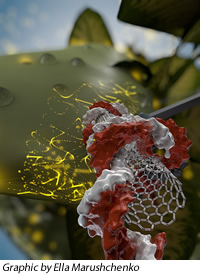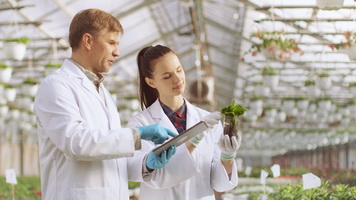CROP BIOTECH UPDATE
---------------------------------------------------------------------------
A weekly summary of world developments in agri-biotech for developing countries, produced by the Global Knowledge Center on Crop Biotechnology, International Service for the Acquisition of Agri-biotech Applications SEAsiaCenter (ISAAA)
---------------------------------------------------------------------------
March 20, 2019
In This Week’s Issue:
News
Global
• Production of Transgenic Plants Increased as Expected, Study Shows
Africa
• Genome Editing Offers Great Prospects for South Africa
Americas
• Strong Sales Figures Indicate Demand for GM Non-browning Apple
Asia and the Pacific
• Australian OGTR Invites Comments on GM Chickpea Field Trial
• USDA FAS-GAIN Evaluates China's 2018 Ag-biotech Industry
• Global Team of Experts Reinventing Sugarcane for More Applications
• Scientists Release Most Complete Genome Assemblies of Cotton
• Experts in Japan Conclude Gene-Edited Foods are Safe
Europe
• Biologists Explain Genetic Origins of Saffron Crocus
Research
• Nicotiana benthamiana as Suitable System for Expression of Cotton Boll Weevil α-amylase Inhibitor
• Soybean Cotyledon Used as Platform for Production of Therapeutic Proteins
New Breeding Technologies
• UC Berkeley Physicist Reports a New High Precision Method for Genetic Engineering and Gene Editing
• Scientists Discover One-Step Genome Editing Technique that Accelerates Seed Breeding
Beyond Crop Biotech
• Modern Beer Yeast Emerged from Mix of European Grape Wine, Asian Rice Wine Yeast
Document Reminders
• GMO Fun Facts: What is GMO in Full?
----
NEWS
----
Global
PRODUCTION OF TRANSGENIC PLANTS INCREASED AS EXPECTED, STUDY SHOWS
Experts from Instituto Politécnico Nacional and Universidad Autónoma del Estado de México conducted a study to analyze the transgenic crop production trends from 1996 to 2016 around the world and the relationship between the area allocated to the cultivation of transgenic crops and the profits generated by this activity. They also highlighted the data in Latin American countries. The results are published in Transgenic Research.
Results showed that despite the significant increase in the area planted with transgenic crops, their production presented a deterministic growth behavior. Production in Brazil, Argentina, Paraguay, and Uruguay increased from 2004 to 2016. The study also showed a positive relationship between the global area planted with transgenics and the corresponding area in these chosen countries.
Read more from research article in Transgenic Research.
Africa
GENOME EDITING OFFERS GREAT PROSPECTS FOR SOUTH AFRICA
 South Africa stands to hugely benefit from genome editing and other modern biotechnologies when products thereof are developed and used within a framework that ensures their sustainability. This was an affirmation coming out from the second National Biosafety Symposium, organized by Biosafety South Africa in Pretoria on March 14, 2019.
South Africa stands to hugely benefit from genome editing and other modern biotechnologies when products thereof are developed and used within a framework that ensures their sustainability. This was an affirmation coming out from the second National Biosafety Symposium, organized by Biosafety South Africa in Pretoria on March 14, 2019.
Addressing ethical, legal and social implications of human genetics research and innovation, Prof. Michael Pepper from University of Pretoria called for inclusion of practical interventions in genome editing in the country. Echoing recommendations from a recent study commissioned by the country's Academy of Science, he recommended that biotech innovations should be incorporated in school curricula to improve public understanding. He also asked for refining of consent models for patients to ensure responsible use of genetic technologies.
At the Symposium, South Africa's Department of Health's Food Control Unit revealed their new findings that residue levels of GMO-associated herbicides in maize products are mostly undetectable and even when detectable, they are more than two orders of magnitude below the national maximum allowable residue levels.
The participants also discussed and acknowledged the regulatory and acceptance challenges faced by entrepreneurs involved with genome editing and other modern biotechnology tools. Leah Bessa, co-founder of the start-up biotech company Gourmet Grubb, which is developing insect-based foods, appealed to regulators to develop formal consultation opportunities for start-up companies. The Symposium was concerned that inadequate technical and financial support are among factors that can derail progress in the region. The stakeholders called for a policy environment conducive to sustainable innovation and observed that a multi-disciplinary approach to biotech innovation is critical to ensure success and sustainable growth in the country's biotech sector.
For more details, contact Biosafety South Africa Executive Manager Dr. Hennie Groenewald on hennie@biosafety.org.za.
Americas
STRONG SALES FIGURES INDICATE DEMAND FOR GM NON-BROWNING APPLE
Jack Bobo, Vice-President of global policy and government affairs with Intrexon, a biotech firm based in the United States, is a staunch supporter of the genetically modified non-browning Arctic Apple which he believes could change the views of the public about GM food. "I like to say it's the most important GMO in the history of the world. Because it's the only GMO that people will buy because it's a GMO," Bobo stated during the U.S. Department of Agriculture outlook forum held last month.
Apples are the third most-wasted food in America. Data shows that around 40 percent of apples in the country are thrown away due to bruising and browning. High sales figures indicate consumers' desire for a non-browning apple as they see its potential to lessen trash and reduce food waste.
Despite claims from biotech activists that the public was not interested in a GM apple and that it would jeopardize Canada's apple industry, the Arctic Apple varieties received regulatory approval from the federal government in 2015. To date, the company has introduced three Arctic Apple varieties — the Arctic golden delicious, Arctic fuji, and Arctic granny smith.
For more details, read the news article in The Western Producer.
Asia and the Pacific
AUSTRALIAN OGTR INVITES COMMENTS ON GM CHICKPEA FIELD TRIAL
The Australian Office of the Gene Technology Regulator (OGTR) invites comments from the public to assess license application DIR 166 from Queensland University of Technology for a field trial of chickpea genetically modified for drought and other abiotic stress tolerance.
The trial is proposed to take place at one site with a total area of 3 hectares per year over a maximum of 6 seasons. The site is in the Tablelands Regional Council in Queensland. The GM chickpea grown in this field trial would not be used for human food or animal feed.
The Regulator has prepared a Risk Assessment and Risk Management Plan (RARMP) for this application and welcomes written submissions on issues relating to the protection of human health and safety and the environment prior to making a decision on whether or not to issue the licence. Submissions should indicate DIR 166 and be received by April 29, 2019.
For more details, read the DIR 166 documents available at the OGTR website.
USDA FAS-GAIN EVALUATES CHINA'S 2018 AG-BIOTECH INDUSTRY
The USDA FAS Global Agricultural Information Network has released its report on China's agricultural biotechnology industry, highlighting the approval of five new biotech traits in imported crops for processing. These are the first five approvals granted in the last one and a half years.
The report also states that the Ministry of Agriculture was renamed into the Ministry of Agriculture and Rural Affairs (MARA), with its biotechnology regulation function remaining the same. MARA has also amended its regulations on safety assessment, import approval, and GMO labeling. Despite the re-structuring and amendments, MARA has still not issued the certificates of cultivation for both the GE corn and GE soy which have been in the approval pipeline since 2016.
The report also includes MARA's campaign efforts to combat the widespread misinformation about agricultural biotechnology in the country, especially in the Chinese social media. Through the campaigns, the Chinese government hopes to turn consumer and public perceptions favorable towards agricultural biotechnology.
Refer to the full report for more details.
GLOBAL TEAM OF EXPERTS REINVENTING SUGARCANE FOR MORE APPLICATIONS
Gene editing of sugarcane for renewable energy and bio-plastics could sustain the industry in the face of falling global demand for sugar.
Professor Robert Henry from Queenslands Alliance for Agriculture and Food Innovation (QAAFI) of the University of Queensland is using gene editing to develop sugarcane to effectively produce biofuels and bioplastics. Together with a global team of experts and as part of a project with US Joint Genome Institute, Prof. Henry is sequencing the sugarcane genome. Full genome sequence is expected to be decoded by 2020.
"Having sugar's genetic template will allow us to look at growing sugarcane as a biofuel and a source of 100 percent recyclable bioplastic, making it a substitute for petroleum in the production of countless items from cosmetics to car parts," he said. "It's about reinventing sugarcane as a crop with a wider range of end uses, and sugarcane is ideal for renewables because it is fast-growing with abundant biomass," he added.
Read more from the University of Queensland.
SCIENTISTS RELEASE MOST COMPLETE GENOME ASSEMBLIES OF COTTON
Zheijiang University professor Tianzhen Zhang and colleagues generated the most complete genome assemblies for two cotton species Gossypium hirsutum and G. barbadense using NRGene's customized DeNovoMAGIC-3 software. The results are published in Nature Genetics.
Despite cotton's wide usage in various industries, little is known about its origin. With the chromosome-by-chromose representation of the two cotton species, scientists and breeders can unlock more of cotton's potential.
"The two cultivated allotetraploid cotton species have striking differences in fiber quality, growth habits, and yields," said Professor Zhang. "As a result of NRGene's tools, we can now compare these two genomes and use them to help us pinpoint the genetic differences responsible for these diverse traits. This can take much of the guesswork out of developing better quality and higher yield cotton as well as of studying cotton origin and domestication."
Read the media release from NRGene.
EXPERTS IN JAPAN CONCLUDE GENE-EDITED FOODS ARE SAFE
 As the global debate on regulation of gene-edited crops continues, countries such as the United States and Japan have come to the conclusion that foods from such crops would not need regulation.
As the global debate on regulation of gene-edited crops continues, countries such as the United States and Japan have come to the conclusion that foods from such crops would not need regulation.
An advisory panel from Japan's Ministry of Health, Labor and Welfare has recommended to allow gene-edited foodstuffs to be sold to consumers without safety evaluations as long as the techniques involved meet certain criteria. "There is little difference between traditional breeding methods and gene editing in terms of safety," said Hirohito Sone, an endocrinologist at Niigata University who chaired the expert panel.
Japan's final report on gene-edited foods has been approved, and an earlier draft states that no safety screening should be required provided the techniques used do not leave foreign genes or parts of genes in the target organism. The panel concluded it would be reasonable to require information on the editing technique, the genes targeted for modification, and other details from developers or users that would be made public while respecting proprietary information.
For more details, read the article in Science.
Europe
BIOLOGISTS EXPLAIN GENETIC ORIGINS OF SAFFRON CROCUS
Saffron crocus (Crocus sativus) is the source of the most expensive spice in the world, with prices going up to 30,000 euros per kilogram. This spice whose aroma comes from apocarotenoid Safranal is produced from manually harvested stigmas, yet, despite its economic importance, its genome and chromosomes are poorly studied.
Researchers in Technische Universität Dresden (TUD) found that saffron crocus is a triploid hybrid species, is sterile, and cannot be bred. Although it has been cultivated for more than 3,500 years, all plants cultivated worldwide come only from daughter bulbs. For almost 100 years, there has been controversy as to the possible parent species of the saffron crocus.
The TUD researchers managed to look into the origins of the saffron crocus and shed light on the parent species using molecular and cytogenetic methods. In a paper published in New Phytologist, they report the autotriploid nature of saffron as a hybrid of wild Crocus cartwrightianus cytotypes.
Saffron crocus descended from the wild species Crocus cartwrightianus found in Greece. Through the genome sequencing of Saffron crocus and comparative chromosome analysis of different crocus species, the biologists were able to demonstrate that genomes of two Crocus cartwrightianus individuals with slight chromosomal differences are fused. These findings conclude the centuries-long search for the origins of this mythical plant.
For more details, read the TUD press release.
Research
NICOTIANA BENTHAMIANA AS SUITABLE SYSTEM FOR EXPRESSION OF COTTON BOLL WEEVIL α-AMYLASE INHIBITOR
Cotton boll weevil is one of the most destructive pests of cotton in the Americas. Institut de L'Environnement et de Recherches Agricoles (INERA) scientist, Severine Lacombe, and colleagues developed an α-amylase inhibitor (α-AIC3) variant using molecular evolution strategy to impede the action of cotton boll weevil (Anthonomus grandis). The findings are published in BMC Biotechnology.
The researchers produced α-AIC3 using a temporary expression system in Nicotiana benthamiana, a relative of tobacco. Structural and functional characterization of α-AIC3 showed that it has the ability to inhibit up to 100% of A. grandis α-amylase, while it had no effect on the α-amylase of two other non-pathogenic insects.
The results imply that N. bethamiana is a suitable system for high-level production of biologically active α-AIC3. The data also suggest that α-AIC3 could be a potential candidate for the production of GM crops with resistance to cotton boll weevil.
Read the research article in BMC Biotechnology.
SOYBEAN COTYLEDON USED AS PLATFORM FOR PRODUCTION OF THERAPEUTIC PROTEINS
The bone morphogenetic protein BMP2 has an important function in the production and regeneration of bone and cartilage, which is vital in maintaining skeletal integrity and bone fracture repair. Thus, BMP2 is commercially produced for clinical use. Researchers from Embrapa Recursos Genéticos e Biotecnologia, Brazil, and partners attempted to express human BMP2 in two plant systems, the lettuce chloroplast and soybean seeds.
The researchers introduced the rhBMP2 gene in two locations of the lettuce chloroplast genome. Analysis showed that BMP2 gene was transcribed but did not accumulate in the leaves.
On the other hand, two soybean events successfully expressed hBMP2 in the transgenic seeds. The recombinant BMP2 protein was administered to C2C12 cell cultures, which induced an osteogenic cascade as manifested in the improved expression of SP7 (osterix) and ALPI (alkaline phosphatase) genes.
The findings suggest that soybeans can be used to produce functional therapeutic proteins like BMP2.
Read more results in Transgenic Research.
New Breeding Technologies
UC BERKELEY PHYSICIST REPORTS A NEW HIGH PRECISION METHOD FOR GENETIC ENGINEERING AND GENE EDITING
 Scientists from the University of California, Berkeley reported a new technique that uses carbon nanotubes to genetically engineer any plant, including gene editing with CRISPR-Cas9, in a simple and speedy method similar to a sewing with a needle and thread. The results are published in Nature Nanotechnology.
Scientists from the University of California, Berkeley reported a new technique that uses carbon nanotubes to genetically engineer any plant, including gene editing with CRISPR-Cas9, in a simple and speedy method similar to a sewing with a needle and thread. The results are published in Nature Nanotechnology.
Physicist Markita Landry grafted the gene of interest onto a carbon nanotube which works like a needle diffusing into plant cells, where the gene is expressed as if it was the cell's own gene. The nanotube is very small (1 nanometer in diameter and several hundred nanometers long), thus it easily slips through the tough cell wall of plants.
Genetic engineering methods usually introduce genes through a gene gun or bacteria. Both have the small chance of getting the job done. Nanotubes, however, are highly successful in delivering a gene into the nucleus and chloroplast. Another advantage of the new method is its capability to protect the DNA from being degraded by the cell, and its ability to prevent it from being inserted into the plant's genome. Thus, the technique allows gene modifications or deletions that in the United States and countries other than the European Union would not trigger the designation "genetically modified".
One of the key uses of this new method is in gene editing, particularly in the delivery of Cas9, which is responsible for targeting and cutting the DNA, along with the DNA encoding guide RNA to edit particular genes accurately.
Read more from the University of California, Berkeley and Nature Nanotechnology.
SCIENTISTS DISCOVER ONE-STEP GENOME EDITING TECHNIQUE THAT ACCELERATES SEED BREEDING
 A group of researchers have discovered a genome editing technique called haploid induction editing (HI-Edit™) technology, which ultimately reduces the time it takes to develop commercial crop varieties.
A group of researchers have discovered a genome editing technique called haploid induction editing (HI-Edit™) technology, which ultimately reduces the time it takes to develop commercial crop varieties.
HI-Edit refers to the reproductive process of haploid induction (HI), which occurs naturally in wheat, corn, barley, and tobacco, combined with a genome editing technology such as CRISPR-Cas9. Using HI-Edit, breeders can modify crops at different stages in the seeds research and development process without the substantial cost and time associated with introgression, which takes up to seven years to fully complete.
While this research focused on field corn and sweet corn crops, there is evidence that the technique could also be applied to wheat. The researchers are also working on similar methods for the genus of plants related to cabbage, broccoli, cauliflower, and kale that could eventually lead to breakthroughs in soybeans and tomatoes.
For more details, read the news release.
Beyond Crop Biotech
MODERN BEER YEAST EMERGED FROM MIX OF EUROPEAN GRAPE WINE, ASIAN RICE WINE YEAST
Saccharomyces cerevisiae, more known as brewer's yeast has been utilized by humans since ancient times to make beer, wine, and baked products. However, the origins of the yeast strain has remained unclear.
A team of researchers led by Justin Fay from the University of Rochester investigated the ancestry of these beer strains, and found that they are actually derived from a mixture of varieties used to make European grape wines and Asian rice wines.
To determine the ancestry of modern beer strains, the scientists made use of the fact that many are known to be polyploid. They compared the genomes of beer yeast strains to those of reference strains isolated from diverse sources and geographic locations. They found ale, baking, and the S. cerevisiae portion of lager strains to have ancestry that is a mixture of European grape wine strains and Asian rice wine strains. The scientists said that early industrial strains spread with brewing technology to give rise to modern beer strains, similar to the spread of domesticated plant species with agriculture.
For more details, read the University of Rochester News & Events.
Document Reminders
GMO FUN FACTS: WHAT IS GMO IN FULL?
GMO becomes a hot topic whenever it is mentioned in Kenya. This is due to fears propagated by opponents of the technology but do people even know what the initials GMO stand for? We asked this question to delegates during the National Devolution Conference 2019, the response was unbelievable. It is important to note that 2019 National Devolution Conference was not open to the general public but only open to self-sponsored delegates and selected National and County Governments officials.
Watch the compiled interviews by ISAAA AfriCenter on Youtube.
(c) 2024. ISAAA.
 South Africa stands to hugely benefit from genome editing and other modern biotechnologies when products thereof are developed and used within a framework that ensures their sustainability. This was an affirmation coming out from the second National Biosafety Symposium, organized by Biosafety South Africa in Pretoria on March 14, 2019.
South Africa stands to hugely benefit from genome editing and other modern biotechnologies when products thereof are developed and used within a framework that ensures their sustainability. This was an affirmation coming out from the second National Biosafety Symposium, organized by Biosafety South Africa in Pretoria on March 14, 2019.  As the global debate on regulation of
As the global debate on regulation of  Scientists from the University of California, Berkeley reported a new technique that uses carbon nanotubes to genetically engineer any plant, including
Scientists from the University of California, Berkeley reported a new technique that uses carbon nanotubes to genetically engineer any plant, including  A group of researchers have discovered a
A group of researchers have discovered a